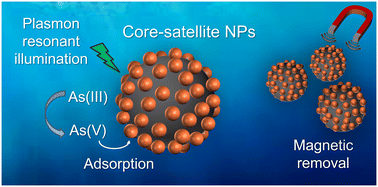Efficient method of arsenic removal from water based on photocatalytic oxidation by a plasmonic–magnetic nanosystem†
Abstract
Arsenic is one of the most toxic elements in natural waters since prolonged exposure to this metalloid can cause chronic damage to health. Its removal from groundwater remains one of the greatest environmental challenges to be addressed nowadays. Here, we present core–satellite hybrid nanostructures formed by plasmonic gold satellites supported onto magnetic iron oxide cores for sunlight-driven remediation of arsenic-containing water. Our experimental results show that the gold nanoparticles catalyze the oxidation of arsenic to much less toxic species and that – upon illumination – the generated heat and hot carriers further enhance the reaction rate. The iron oxides act as an arsenic adsorbent, enabling the complete removal of the catalysts and the adsorbed oxidized arsenic species through a magnet. We quantified the different catalytic contributions, showing that the plasmonic one is of the same order as the surface one. This work highlights the synergy between plasmonic catalysts and iron oxides for light-assisted water remediation.

- This article is part of the themed collection: Environmental Science: Nano Recent HOT Articles


 Please wait while we load your content...
Please wait while we load your content...